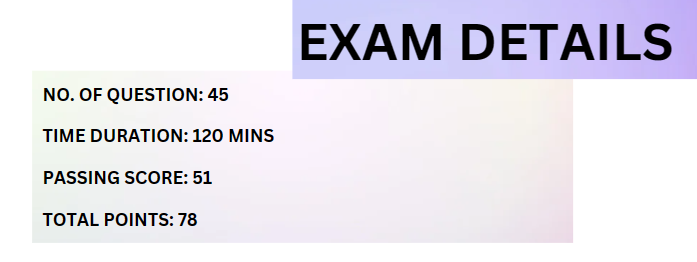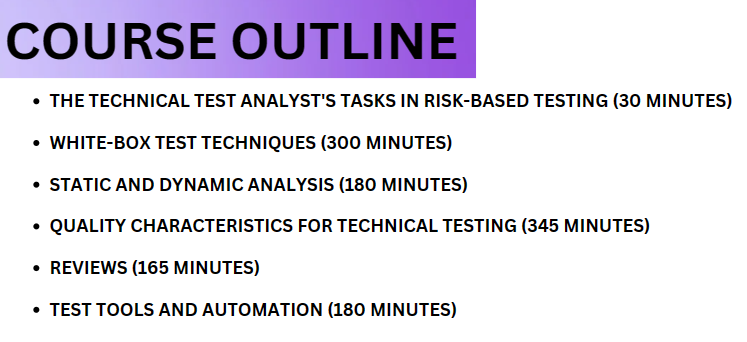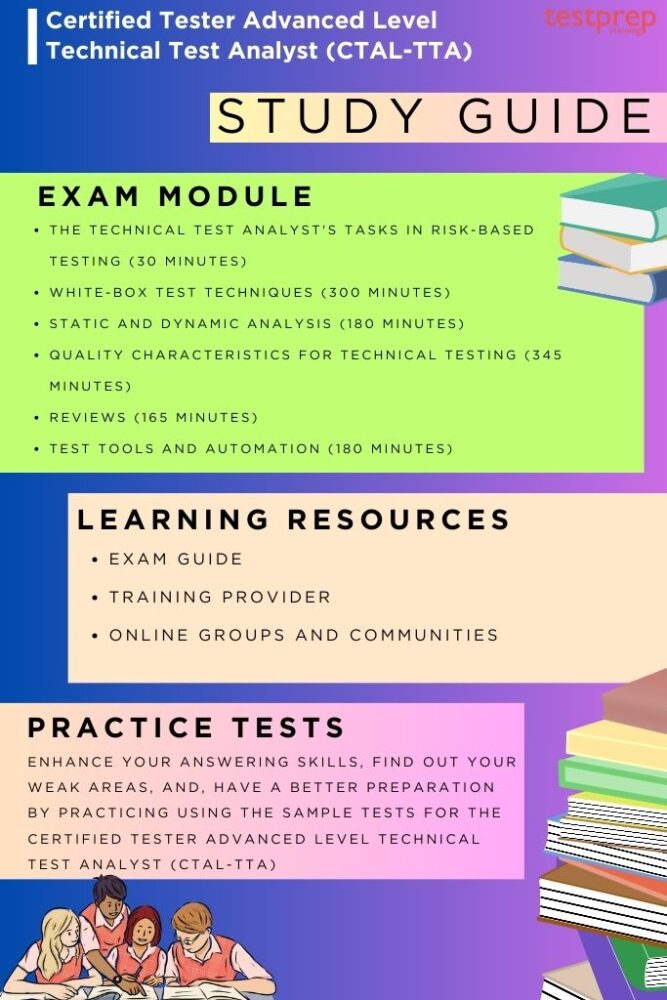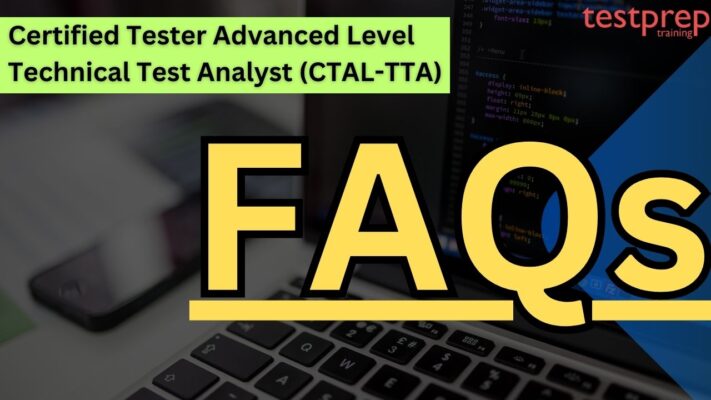Certified Tester Advanced Level Technical Test Analyst (CTAL-TTA)

The ISTQB® Advanced Level Technical Test Analyst (CTAL-TTA) is like a deep dive into the important technical testing skills that many organizations need. You’ll learn about risk-based testing, white box testing, static and dynamic analysis, non-functional testing, and test automation.
Target Audience:
The Advanced Level Technical Test Analyst certification is for those engaged in testing or wanting to enhance their software testing skills. It’s beneficial for people doing tasks like test analysis, test consulting, and software development.
To get certified, you need the Certified Tester Foundation Level certificate and practical experience. You can check with an ISTQB® Member Board or Exam Provider for the exact practical experience requirements.
What you will learn?
A person who earns the Advanced Level Technical Test Analyst certification should be able to:
- Identify and categorize common risks related to the performance, security, reliability, portability, and maintainability of software systems.
- Contribute technical aspects to the planning, design, and execution of tests to address performance, security, reliability, portability, and maintainability risks.
- Choose and apply suitable white-box test techniques to ensure tests offer sufficient confidence based on design coverage.
- Actively participate in reviews with developers and software architects, utilizing knowledge of typical defects in code and architecture.
- Enhance the quality of code and architecture using various analysis techniques.
- Describe the expected costs and benefits of introducing specific types of test automation.
- Pick the right tools to automate technical testing tasks.
- Comprehend the technical issues and concepts involved in applying test automation.
Exam Details

- The exam comprises 45 questions, each carrying one point, for a total of 78 points.
- To pass, you need to score at least 51.
- The exam duration is 120 minutes, with an additional 25% of the time provided for non-native language speakers.
Course Outline
The resources you need to study are divided into six chapters, each with a specific minimum time recommendation indicated by the main heading. However, the timing details are not specified for sections within each chapter. If you’re taking accredited training courses, the syllabus mandates a minimum of 20 hours of instruction, divided among the six chapters in a particular way.

The Technical Test Analyst’s Tasks in Risk-Based Testing- 30 mins.
Testing
1.2 Risk-based Testing Tasks
TTA-1.2.1 (K2) Summarize the generic risk factors that the Technical Test Analyst typically needs to consider
TTA-1.2.2 (K2) Summarize the activities of the Technical Test Analyst within a risk-based approach for testing activities
White-Box Test Techniques – 300 mins.
2.2 Statement Testing
TTA-2.2.1 (K3) Design test cases for a given test object by applying statement testing to achieve a defined level of coverage
2.3 Decision Testing
TTA-2.3.1 (K3) Design test cases for a given test object by applying the Decision test technique to achieve a defined level of coverage
2.4 Modified Condition/Decision Testing
TTA-2.4.1 (K3) Design test cases for a given test object by applying the modified condition/decision test technique to achieve full modified condition/decision coverage (MC/DC)
2.5 Multiple Condition Testing
TTA-2.5.1 (K3) Design test cases for a given test object by applying the multiple condition test technique to achieve a defined level of coverage
2.6 Basis Path Testing (has been removed from version v4.0 of this syllabus)
TTA-2.6.1 has been removed from version v4.0 of this syllabus.
2.7 API Testing
TTA-2.7.1 (K2) Understand the applicability of API testing and the kinds of defects it finds
2.8 Selecting a White-box Test Technique
TTA-2.8.1 (K4) Select an appropriate white-box test technique according to a given project situation
Static and Dynamic Analysis – 180 mins.
3.2 Static Analysis
TTA-3.2.1 (K3) Use control flow analysis to detect if code has any control flow anomalies and to measure cyclomatic complexity
TTA-3.2.2 (K3) Use data flow analysis to detect if code has any data flow anomalies
TTA-3.2.3 (K3) Propose ways to improve the maintainability of code by applying static analysis
3.3 Dynamic Analysis
TTA-3.3.1 (K3) Apply dynamic analysis to achieve a specified goal
Quality Characteristics for Technical Testing – 345 mins.
4.2 General Planning Issues
TTA-4.2.1 (K4) For a particular scenario, analyze the non-functional requirements and write the respective sections of the test plan
TTA-4.2.2 (K3) Given a particular product risk, define the particular non-functional test type(s) which are most appropriate
TTA-4.2.3 (K2) Understand and explain the stages in an application’s software development lifecycle where non-functional testing should typically be applied
TTA-4.2.4 (K3) For a given scenario, define the types of defects you would expect to find by using the different non-functional test types
4.3 Security Testing
TTA-4.3.1 (K2) Explain the reasons for including security testing in a test approach
TTA-4.3.2 (K2) Explain the principal aspects to be considered in planning and specifying security tests
4.4 Reliability Testing
TTA-4.4.1 (K2) Explain the reasons for including reliability testing in a test approach
TTA-4.4.2 (K2) Explain the principal aspects to be considered in planning and specifying reliability tests
4.5 Performance Testing
TTA-4.5.1 (K2) Explain the reasons for including performance testing in a test approach
TTA-4.5.2 (K2) Explain the principal aspects to be considered in planning and specifying performance testing
4.6 Maintainability Testing
TTA-4.6.1 (K2) Explain the reasons for including maintainability testing in a test approach
4.7 Portability Testing
TTA-4.7.1 (K2) Explain the reasons for including portability testing in a test approach
4.8 Compatibility Testing
TTA-4.8.1 (K2) Explain the reasons for including coexistence testing in a test approach
Reviews – 165 mins.
5.1 Technical Test Analyst Tasks in Reviews
TTA 5.1.1 (K2) Explain why review preparation is important for the Technical Test Analyst
5.2 Using Checklists in Reviews
TTA 5.2.1 (K4) Analyze an architectural design and identify problems according to a checklist provided in the syllabus
TTA 5.2.2 (K4) Analyze a section of code or pseudo-code and identify problems according to a checklist provided in the syllabus
Test Tools and Automation – 180 mins.
6.1 Defining the Test Automation Project
TTA-6.1.1 (K2) Summarize the activities that the Technical Test Analyst performs when setting up a test automation project
TTA-6.1.2 (K2) Summarize the differences between data-driven and keyword-driven automation
TTA-6.1.3 (K2) Summarize common technical issues that cause automation projects to fail to achieve the planned return on investment
TTA-6.1.4 (K3) Construct keywords based on a given business process
6.2 Specific Test Tools
TTA-6.2.1 (K2) Summarize the purpose of tools for fault seeding and fault injection
TTA-6.2.2 (K2) Summarize the main characteristics and implementation issues for performance testing tools
TTA-6.2.3 (K2) Explain the general purpose of tools used for web-based testing
TTA-6.2.4 (K2) Explain how tools support the practice of model-based testing
TTA-6.2.5 (K2) Outline the purpose of tools used to support component testing and the build process
TTA-6.2.6 (K2) Outline the purpose of tools used to support mobile application testing
Certified Tester Advanced Level Technical Test Analyst (CTAL-TTA) FAQs
Certified Tester Advanced Level Technical Test Analyst (CTAL-TTA) Study Guide

1. Understand Exam Objectives
Knowing the exam objectives is crucial for candidates because it helps them focus their preparation efficiently, saving time. The preparation guide underscores the significant role this understanding plays. Here are the objectives for the Certified Tester Advanced Level Technical Test Analyst (CTAL-TTA) exam.
- The Technical Test Analyst’s Tasks in Risk-Based Testing (30 minutes)
- White-Box Test Techniques (300 minutes)
- Static and Dynamic Analysis (180 minutes)
- Quality Characteristics for Technical Testing (345 minutes)
- Reviews (165 minutes)
- Test Tools and Automation (180 minutes)
2. Look for a Training Provider
You can get training from Accredited Training Providers, either in a classroom, virtual, or e-learning format. We strongly suggest going for accredited training because it means an ISTQB® Member Board has checked the materials to make sure they align with the syllabus. If you prefer to study on your own, using the syllabus and recommended reading material is also a valid option for exam preparation.
3. Join Online Study Groups
Engaging in ISTQB online study groups and communities can make a significant difference for those aiming to excel in software testing. These groups, typically formed by individuals preparing for ISTQB certifications, create a collaborative and supportive atmosphere. Joining these groups allows you to share insights, discuss challenging topics, and gain diverse perspectives on testing methodologies and best practices. The combined knowledge within these communities can deepen your understanding of the ISTQB syllabus, and members often share valuable resources and tips for exam preparation.
Whether you’re new to the field or an experienced professional wanting to stay updated, these online study groups provide a special space to learn, ask questions, and stay informed about the latest trends in software testing. The connections formed in these communities can contribute to both personal and professional growth, making the journey towards ISTQB certification more engaging and rewarding.
4. Take Practice Exam Tests
Practicing with exam tests is a vital part of getting ready for the ISTQB certification exam. These tests give you a trial run of the real exam, letting you get used to the format, types of questions, and time limits. Doing practice exams helps you figure out what you’re good at and where you might need more focus, helping you adjust your study plan. It’s not just about testing what you know; it’s also about gaining confidence and reducing nerves on exam day.
Plus, the immediate feedback from practice tests helps you understand why certain answers are correct, reinforcing important concepts. Regular practice exams really boost your preparedness, ensuring you go into the certification exam with a strong grasp of the material and the confidence to do well.



